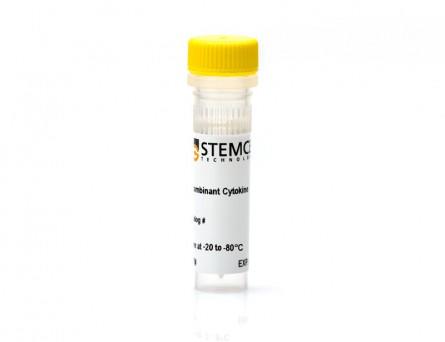STEMCELL Technologies PancreaCult PancreaCult Organoid Growth Medium (Human)
- 研究用
- 新製品
PancreaCult™ (Human) は、ヒト膵管/膵外分泌組織からオルガノイドを樹立、増殖、および維持する培地システムです。ヒト膵臓オルガノイド培養のための、完全で堅牢なワークフローを提供します。
ヒト膵臓オルガノイドは、組織からのオルガノイド形成率を高めるように最適化されたPancreaCult™ Organoid Initiation Medium(OIM)(ST-100-0820)を用いて、新鮮または凍結保存された膵島枯渇外分泌画分から樹立します。
次に、培地をPancreaCult™ Organoid Growth Medium(OGM)(ST-100-0781、本品)に切り替えて、継代、長期維持、血清フリー条件の薬剤スクリーニング、あるいは凍結保存します。
PancreaCult™ (Human) で増殖したオルガノイドは、Transwell®を使用した2次元単層培養、希釈したCorning® Matrigel®による浮遊培養、ハイスループットアッセイ対応の培養フォーマットなど、さまざまな培養プロトコルに適合します。
本品はHUBとの共同開発製品です。商業目的で使用する場合は、HUB(www.huborganoids.nl/)へご連絡の上、商用ライセンスまたはHUBとのライセンスに関する説明を受けてください。
製品の特長
*本品は、ヒト膵臓オルガノイドを長期維持および継代するための培地です。膵島枯渇外分泌画分からのオルガノイド樹立には、PancreaCult™ Organoid Initiation Medium(OIM)(ST-100-0820)をご利用ください。
PancreaCult™ Organoid Media (Human) で、ヒト膵管オルガノイドを樹立、増殖、維持
- さまざまなドナーの膵臓から、正常および腫瘍由来のオルガノイド培養を開始、拡大
- EGFを除去することで、KRAS活性化がん細胞から正常細胞を除外
- 無血清の維持培地を用いて、薬剤スクリーニングにおける干渉と変動を低減
- 柔軟な培養フォーマットで、ハイスループットな薬剤スクリーニングを実施
ヒト膵管オルガノイドを用いたハイスループットな薬剤試験の手順については、こちらをご覧ください。
使用方法
PancreaCult™ Human Enables Initiation and Expansion of Pancreatic Ductal Organoids
Human pancreatic ductal organoids are initiated in PancreaCult™ OIM for the first 3 days of culture, then switched to PancreaCult™ OGM for the remainder of culture. Alternatively, organoids can be grown in PancreaCult™ OGM for a completely serum-free protocol, however, proliferative pancreatic ductal cells are better supported in PancreaCult™ OIM during the first 3 days of culture. Cultures should be passaged after 7 days with further medium changes every 2-3 days. Pancreatic ductal organoids are suitable for experimentation or banking after one full passage in PancreaCult™ OGM.
詳細は英語マニュアルをご確認ください (Technical Manual)。
データ紹介
ヒト膵管オルガノイド
PancreaCult™ Organoid Initiation Medium (OIM; Human) and Organoid Growth Medium (OGM; Human) support the initiation and expansion of human pancreatic duct organoids from pancreatic tissue or previously established organoid cultures. Shown are organoids grown using PancreaCult™ OIM and OGM and imaged on day 7 of passage 3.
膵管オルガノイドの安定した増殖

(A) Organoid expansion in PancreaCult™ OGM provides robust expansion of organoids across different donors. (B) Organoids may be initiated in PancreaCult™ OGM for a completely serum-free workflow, however, initiation and maintenance of damaged tissue is better supported by initiating cultures in PancreaCult™ OIM. (C) Comparison of PancreaCult™ Human to two different DIY formulations showed more robust expansion of organoids in PancreaCult™ Human. Shown is the cumulative fold expansion of organoid fragments as counted at the end of each passage.
膵管上皮の特徴を示すマーカーを発現
Organoids grown using the PancreaCult™ (Human) display marker expression consistent with the pancreatic ductal epithelium when imaged using immunocytochemistry. Shown are organoids grown in PancreaCult™ OGM and stained for (A) pancreatic ductal marker CK19, (B) pancreatic ductal marker SOX9, (C) epithelial marker EPCAM, (D) proliferation marker KI67, (E) apical pancreatic duct marker MUC1, and (F) pancreatic ductal marker CA2. Organoids were imaged on passage 2 (A), passage 3 (B, C) or passage 10 (D-F).
膵外分泌組織と類似した膵臓マーカーを発現

Pancreatic duct organoids grown using the PancreaCult™ Human show marker expression levels similar to those observed in exocrine tissue. Analysis by qPCR showed pancreatic duct organoids were enriched for (A) PDX1 (C) CK19 and (F) LGR5 as compared to total pancreatic tissue, demonstrating enrichment of proliferative duct organoids. Comparable expression of (B) SOX9, (D) cystic fibrosis transmembrane receptor (CFTR), and (E) CA2 was observed in pancreatic duct organoids. Expression levels are normalized to TBP and UBC housekeeping genes (ΔCT) and total pancreas for relative expression levels (ΔΔCT).








